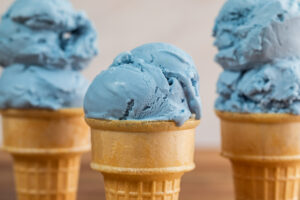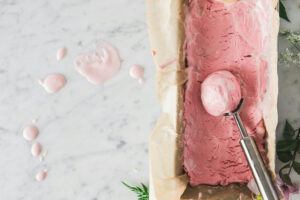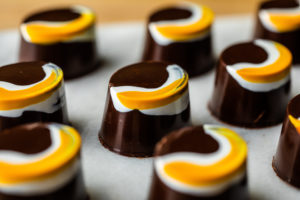With so many different types of natural colors, choosing the right one for your dairy application can feel overwhelming. Whether you’re creating yogurt, milk, process cheese, or ice cream there are some important factors to consider when choosing a natural color. We’ve broken down the top 5 considerations for coloring dairy to help make your decision easier.
1. Ingredient Interactions
Before choosing a natural color for your dairy product, you’ll want to understand how ingredients in the formula might react with your chosen color. Certain ingredients in cultured dairy products, like yogurt or kefir, could interact with certain natural colors. Flavor ingredients can also impact which color(s) you choose. For example, the emulsification system for tropical flavors like mango and banana may be incompatible with color emulsions like beta-carotene or paprika colors, as seen in the below image. To avoid this, you can add these ingredients separately to prevent potential breaking of color emulsions.
What natural color format will work best in your formulation – oil or water soluble? Or would an emulsion be a better option? If you’re using annatto in yogurt or fruit prep, you’ll want to choose an emulsified format over a water-soluble version because these applications are below a pH 4.6, which can cause water-soluble annatto to precipitate. For process cheese, on the other hand, oil-soluble annatto is usually chosen to avoid pinking, which can occur with water-soluble annatto in this application.
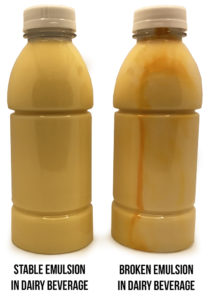
Finally, you should consider if the natural color is compatible with the dairy base. Do you want a bold blue or vibrant purple shade for an ice cream? Some natural colors, like anthocyanins, are not stable at the neutral pH of ice cream and will fade from their original, vibrant color to a light purple or gray shade over time. For blues to purples that will maintain their vibrancy, opt for spirulina or a blend of spirulina and red beet.
2. Processing Time & Temperature
One of your first considerations will be the processing time and temperature of your dairy application. Dairy products often undergo a high temperature, short duration heat pasteurization process, so it’s critical to choose heat stable natural colors that can withstand this process. Annatto, Emulsitech® beta-carotene and paprika, and class I caramels are all colors that are well-suited for pasteurized dairy products.
However, care should be taken when using colors like red beet, especially in fruit preparations for products like fruit-on-the-bottom yogurt or ice cream swirls. In these cases, the ideal processing would be a short duration pasteurization followed by fast cooling through a heat exchanger to prevent color fade. If you’re your process utilizes slow cooling at an ambient temperature, anthocyanins like Amaize® red or purple carrot might be better red options.
3. Finished Product Characteristics
Matching a natural color to the intended flavor is important to consumers and can help create a point of differentiation for brands. For example, the target shade for your lemon-flavored ice cream might color a bright, bold turmeric, while a competitor might have a more pastel shade using beta-carotene. Many color blends can be made to achieve the perfect match for a particular flavor profile or to replace synthetics while still meeting customer flavor expectations.
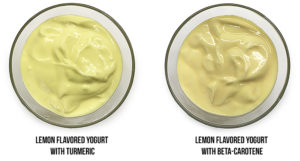
Another consideration is whether the processing conditions will affect the final look of the product. When ice cream is made, part of the process is whipping in air. Some novelty ice creams incorporate less air into the final product, so the color won’t lighten as much, while some of the more economically priced ice creams or frozen desserts, may have more aeration. The latter will often require you to overdose the color (or add more color than you need upfront) to account for fading due to the large volume of air that’s incorporated.
4. Regulatory Considerations
Knowing the country or region of final sale for your product can help narrow down the options when choosing a natural color. Countries may have different legal requirements or limitations on which colors can be used. For example, sodium copper chlorophyllin can be used in Canada to create mint chip ice cream colors but has a 300-ppm usage limit. In the US, it’s not approved for use in dairy so other color blends would be needed, such as spirulina and beta-carotene or turmeric.
Along with knowing the regulatory requirements, it is also important to know how each color will affect the customer’s finished product label. Although carmine may provide a nice red hue for a strawberry ice cream, it does not qualify for vegan, kosher, or halal status. In this case, you could blend red beet color with beta-carotene to allow for these claims.
5. Storage & Packaging
How will your snack product be packaged and stored? Choosing the correct packaging for your dairy product when using natural colors will also be a critical component. Some natural colors, such as turmeric, spirulina, and beet will fade when exposed to light, so opaque packaging is the best choice to prevent fading. If your product has transparent packaging or a clear window, you’ll need to choose colors that are more light-stable like beta-carotene.

Figuring out how to choose the right natural color for your dairy application can be difficult, but when you choose the right one, your scrumptious dairy will crush the competition! Need some help deciding? Contact us with your questions or get started with an ice cream sample kit.

